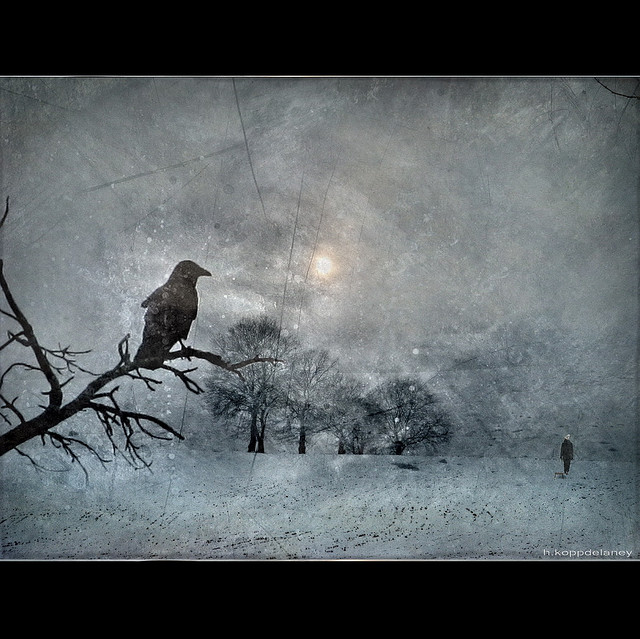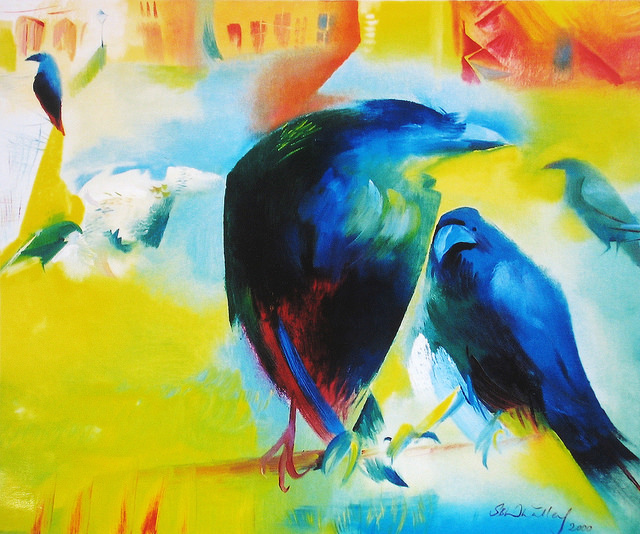This is a book of dreams: tree-houses; talking birds, the lost feminine, found.
Wilder Island, a mysterious, mythical island that symbolizes (in my mind) the earth herself, is inhabited by the Corvus (crows or ravens), keepers of an ancient, almost lost language. Almost lost, that is, to humans.
Fortunately, there are humans known as Patua’ who can communicate with the Corvus in this language. Alfredo Manzi, the lone Jesuit priest and professor of ornithology who comes to Wilder Island with the intention of turning it into a bird sanctuary, is one of them.
As the story begins, we witness Jade’s nightmare: crows, shattering glass, a precious medallion given to her by her unknown mother (we think) who disappeared when Jade was very young. Jade’s husband Russ, an academic peer of Manzi, comforts her, tries to convince her that her dream is merely an echo of the previous day’s events and conversation.
But Jade, an artist and believer in beauty, knows her dream means much more.
image: “Reflections of Winter” used by permission of the artist, h. koppdelaney via Creative Commons license.
As a student of dreams, a lover of earth and believer in beauty, I am often one who speaks a language almost lost. I often find myself at odds with what is: too much noise, too many things, too much doing, so I deeply identified with one character in particular, Charlotte, she having been institutionalized her entire adult life and unable to communicate with most humans in language they could understand.
What happens in this eco-fantasy happens in reality: women stand up for their sanity and autonomy (with help or without it); money changers pollute and plunder the earth; people, acting alone or banding together, go to war over pieces of this planet (who owns it or how to treat it), all the while trying to understand or completely ignoring the language of the other.
Enter: the hero.
image: “Ravens at the Tower” 2000 used with permission of the artist, Stephen B. Whatley. View more of his work here. Read his profile on Wikipedia here.
The author of this layered allegory, Mary C. Simmons, has successfully given the role of hero to her crow characters. They are funny and wise, silly and sly and believable. These savvy creature-beings indeed point the way.
I don’t know about you, but I have to believe that together we can make the kind of relationship between animals (human and creature-beings) and between animals and earth happen that this author postulates can happen.
I loved this book. -&-having never dreamed of crows before, and after reading the first few chapters of it, I did dream of them and then wrote the following verse:
for Mary C. Simmons
crows
carry
fallen oak
trunk of peace
these
do not
fly
they rise
~
such
a thing
i have
not seen
but dream
~
of trees
& crows
constructing
—architects
scrubbing
sky
~
how
(i wonder)
what if
dreams
are crystal
what if
feathers
ruled:
soft
curious
gesture
clever
ubiquitous
aim
~
// men //
are stone
ether
gathered
stacked
& after?
Look for an interview with Mary C. Simmons coming soon on this blog!
D. Ellis Phelps is the author of Making Room for George, Balboa Press, 2013.



Reblogged this on 411 on Books, Authors, and Publishing News and commented:
Eloquent review!
LikeLiked by 1 person
Thank you, Debra! #Busybeedebs
LikeLiked by 1 person
This sounds like the book I want to write! Will check it out.
LikeLiked by 1 person
Great! Also check out the author’s blog here: http://authormarycsimmons.com
LikeLike
By the way, congrats on your recent marriage. May you grow Great Love.
LikeLike
Thank you.
LikeLike
[…] Corvus Rising […]
LikeLike